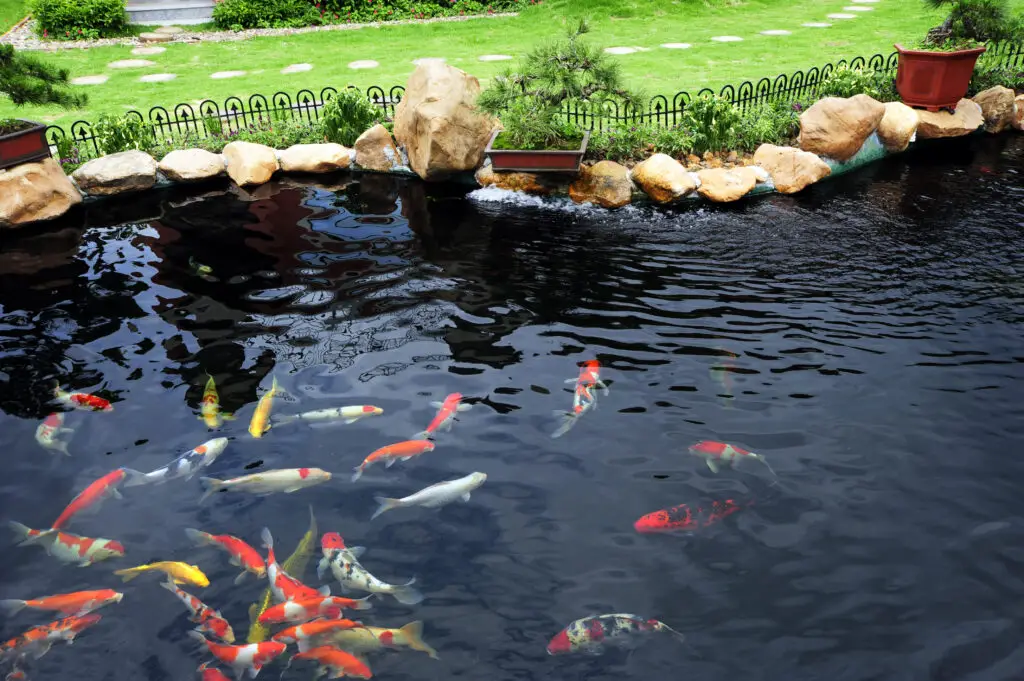
Successful maintenance of a koi pond requires that you provide your koi fish with the correct water quality and environment to suit their optimal health and growth. To do this, you must provide your koi pond with the proper filtration system to serve its unique needs. Luckily for koi fish owners, there is a simple filtration system set-up available for installation in ponds to benefit your koi fish.
Two types of filtration systems: gravitational filtration pumps water up from your pond into the filter using a submersible water pump. The water flows down through the filters into the pond. Pressurized filtration uses a pump to move the water through the various filters and back into the pond.
Knowing the fundamentals of what kinds of filtration are necessary for a koi pond is just the beginning. The next phase is to understand better how these filtration systems work and why they are required. This understanding includes any other mechanisms or procedures you must install to complement and complete the filtration system.
Pro Tip: If you’re tired of wasting money and making costly mistakes on the koi-keeping hobby or are thinking about buying koi fish but don’t know where to start, I strongly suggest you check out this ebook. I recently read this ebook, and it contains SO much useful information, such as:
- 3 proven steps to identify koi fish diseases
- WARNING: 3 things you should NEVER do when it comes to caring for koi
- When to seek professional help when it comes to looking after your koi
How Do You Filter A Koi Pond?
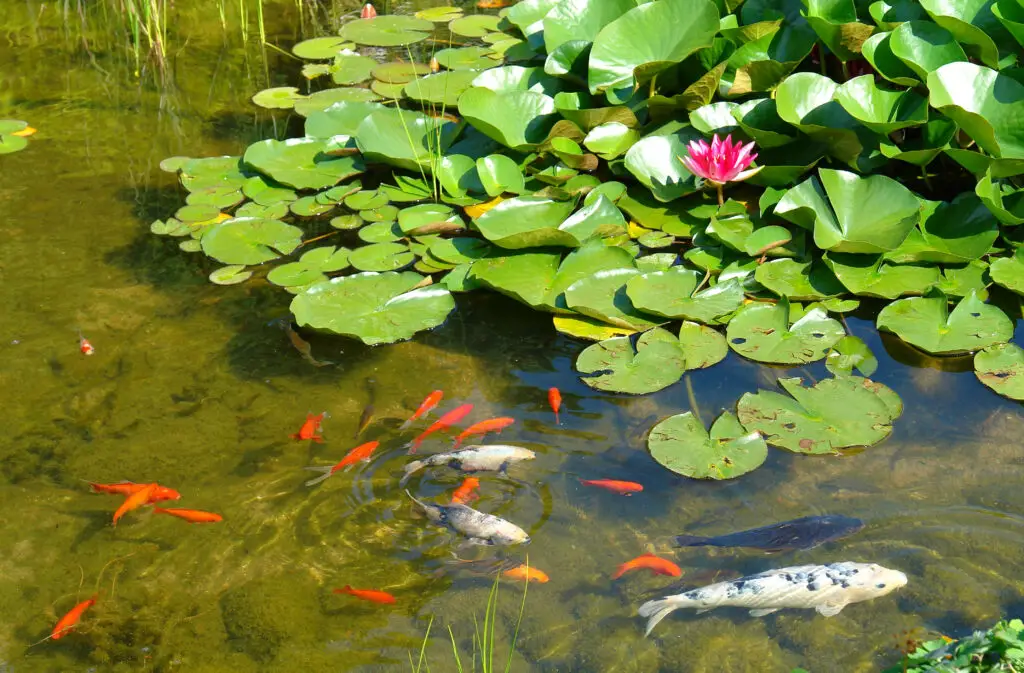
There are two primary methods to filter your pond regarding koi pond filtration. You can either filter your pond through a gravitational filtration system or a pressurized filtration system. Let’s take a detailed look at each of these systems.
Gravitational Filtration System
Gravity filters require that you place them above your pond’s water level. This system pumps water up from your pond into the filter using a submersible water pump. Once in the filter, it uses gravitational force to flow through the various mechanical and biological filtering chambers or layers before flowing back into the pond. The returning water can flow straight into the pond or through a waterfall-type feature.
Pressurized Filtration System
A pressurized filtration system works similarly to a pool filtration system. It uses an external water pump to pump water through a sand or bubble bead filter, filtering out as much solid organic waste matter from the pond as possible.
You can place this system below your pond as it does not require gravity, and you can have the water that comes out of the filter pumped back into your pond through a water feature. Ensure you do not place this filtration system more than one meter above your pond’s water level.
Installing a bottom drain in your koi pond is extremely handy when working with this filtration method. With a bottom drain installed, water and solids from your pond can be channeled towards the bottom of your pond, flowing out of the drain into the pipe that will carry it into the filtration system. Depending on your preference and the size and build of your koi pond, there are a few different types of bottom drains that you could install in your koi pond.
What Are The Two Main Processes Of Koi Pond Filtration?
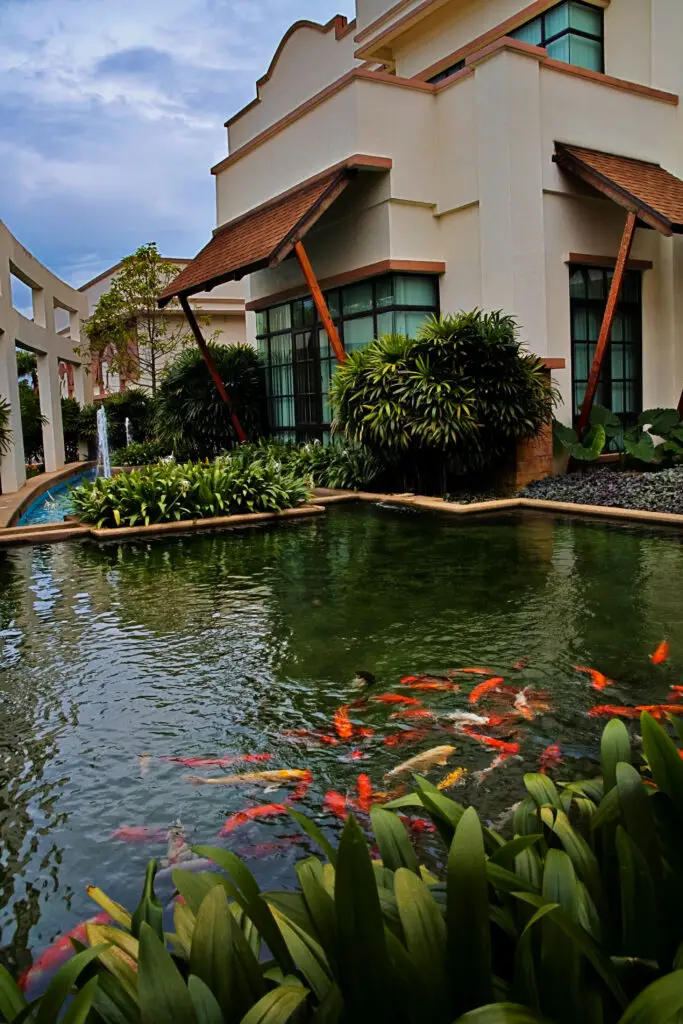
Your average koi pond must undergo two primary filtration processes: mechanical and biological. Each of these filters has its unique mechanisms and processes. Let’s take a look at these filtration processes.
Mechanical Filtration
Your koi pond’s water will first go through a mechanical filtration process. This process is essential, and it must occur before biological filtration. The main job of mechanical filtration is to remove as much solid organic matter from the water as possible, including fish feces, leaves, algae, and other organic matter.
Suppose the mechanical filter is not sufficiently effective in its job. In that case, the solid particles that slip through can clog up the biological filter, which can have serious adverse effects on the pond’s water quality and negatively affect your koi fish.
You can choose one of many various filtration mechanisms for your mechanical filtration system, depending on which filter system you use.
Gravity Filter Systems
Usually, the media employed are layers of differing materials, including sponges or brushes. The water initially filters through a coarse filtration. It moves onto a finer filtration before going through an even finer layer and moving onto the biological filtration.
You can locate the biological filter underneath the mechanical filtration system filters. The system then uses gravity to get the water through the different layers to the bottom, eventually passing through the biological filter.
The larger solids get caught in the largest, coarsest filter through this process. As each filter gets finer, smaller particles are caught, preventing most particles or solids from moving into the biological filter.
Pressurized Filtration Systems
There are two main types of medium used in pressurized filtration systems: sand and bubble bead filters.
Sand filters work similarly to your average pool filtration system. When you purchase your sand filter, ensure that you buy one for a koi pond and not one designed for your average swimming pool. The sand filters designed for koi ponds have a bigger grain of sand, larger filter fingers, and easy-access lids. All of these features make it easier to maintain in a pond situation.
Sand filters work by trapping solids that are present in the water. One major drawback of a sand filter used in a pond is that it quickly gets clogged up. Because of this, you will need to backwash your system multiple times a week.
Included in this maintenance plan should be a manual hand backwash of your system once a week. This hand backwashing is essential as the sand used in these pond systems is coarser, and hand backwashing helps break up crusts that can form on the top of sand filters. You will also need to change your sand filters sand every 1 – 2 years.
Bubble bead filtration is somewhat different from the sand filtration process. The filter uses tiny plastic beads that float around inside the filter in this process. Solids from the pond water get trapped underneath these beads. An air blower then blows air into the filter to displace the solids from the plastic beads.
Once this displacement process is complete, the filtration system must undergo a backwash similar to the sand filtration system. The significant benefit of the bubble bead filtration system is that the plastic beads do not need to be changed, and they also act as a biofiltration media.
Biological Filtration
The biological filtration system has three major components. The first is the media inside your mechanical filter or in a separate piece along the filtration process; this depends on if you use a gravitational or pressurized filtration system. The second is aeration, and the third is aquatic plants.
Biological filtration encompasses the process of promoting helpful bacterial growth in an aquatic environment. Koi fish produce ammonia through metabolic waste, which is also made naturally during the breaking down of organic matter. In large quantities, ammonia can be toxic to fish. In a pond environment, ammonia levels can rise relatively quickly, creating a dangerous situation for koi fish living in the pond.
Depending on the type of filtration, whether gravity filtration or pressurized filtration, will depend on where you place your biological filter. Regardless of where you place it and which method you use, it undergoes the same process. Inside the biological filter, you will find bio media, and this media serves as a platform onto which the beneficial bacteria latch. There are a few different types of biological media, such as:
- Ceramic bio rings
- Bio balls
- Lava rock or other porous rock
- Plastic shapes that yield high surface area
The larger the surface area of the biological media, the better, as this offers more space for the beneficial bacteria’s expansion and growth. There are two major types of beneficial bacteria located in a biological filter. The first type breaks the ammonia down into nitrites, and the second type breaks them down further into nitrates, which are pretty much harmless to your fish at low levels.
These beneficial bacteria are oxygen-loving, and because of this, it is a good idea to ensure that your pond’s water is well-oxygenated. You can add oxygen to your water in several ways, such as:
- Waterfalls into the pond
- Using an air pump or blower
- Aquatic plants
Ensuring that your koi pond has good aquatic plant life is very important. Aquatic plants not only provide shelter and shade for your koi fish and a natural space for females to attach their eggs, but they also help to break down waste, support beneficial micro-organisms, and oxygenate the water.
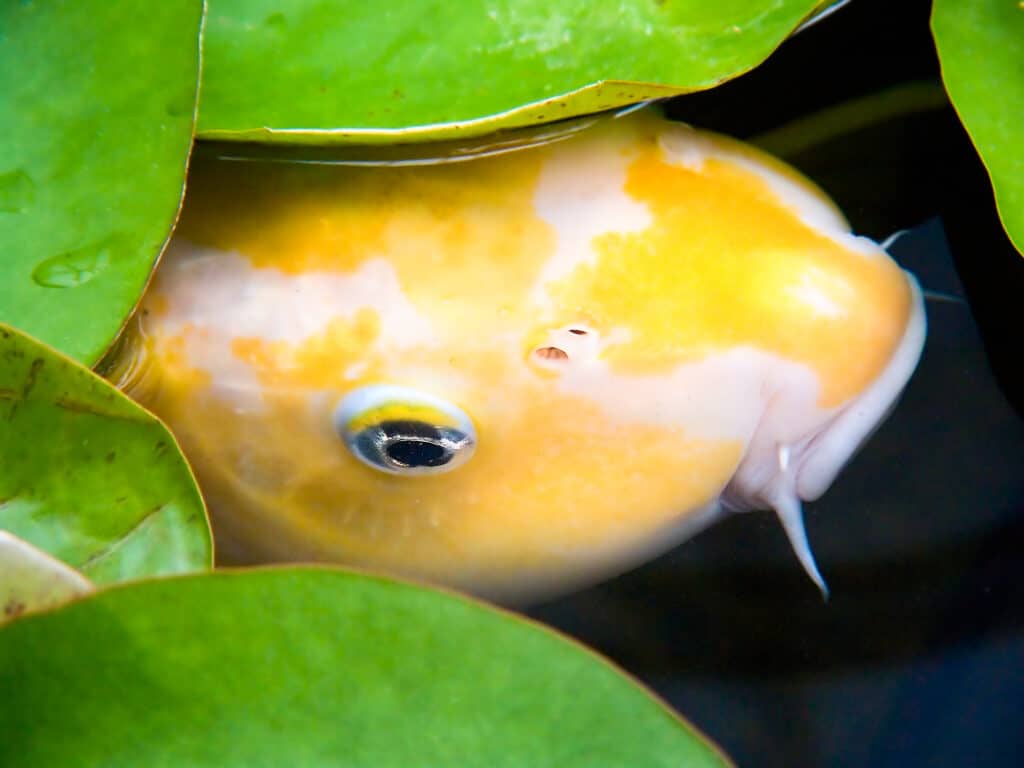
Additional Options For Filtering Your Koi Pond
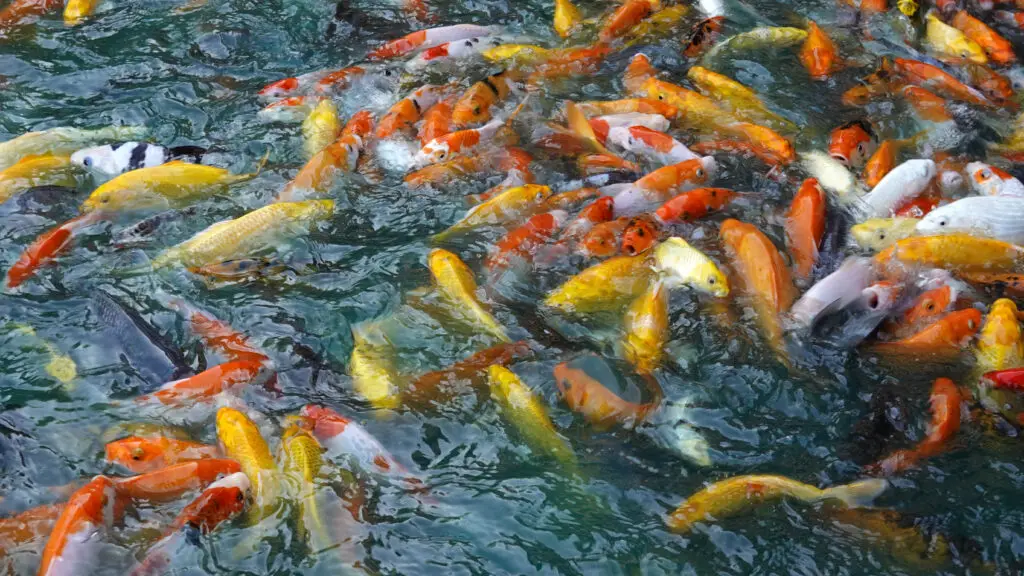
There are some additional options that you can use to aid your koi pond filtration system. These include UV filtration, a skimmer, and a pre-filter. Let’s take a look at these three additional options.
UV Filtration
UV (ultraviolet) filtration is becoming increasingly popular among koi fish owners. You can utilize this filtration method before or after the biofilter, as it aids in controlling pathogen and algae growth and maintaining the clarity of your pond’s water.
UV filtration works by dosing the phototrophic bacteria, algae, viruses, mold, or protozoans with UV radiation. This UV radiation helps to destroy these micro-organisms and prevents any further re-growth. One thing to remember when considering your UV filtration system is that the strength of the wattage of your UV bulb will depend on the size of your pond. Remember to replace your bulb often to keep it working optimally.
Skimmers
You use your skimmer in conjunction with your bottom drain. Skimmers are another form of mechanical filtration as they skim the surface of your pond, collecting floating debris in the form of grass, leaves, pollen, etc. Skimmers pull the top pond water towards themselves, effectively collecting the surface waste and filtering the water before it goes into the pump.
Skimmers are also responsible for removing dissolved organic matter from the surface of your pond. If you choose not to use one, you might find that the surface of your pond starts to get an oily film, reducing the atmospheric oxygen’s ability to diffuse into your pond through the surface of the water.
Pre-Filter Filter
Pre-filters are not usually necessary unless you have located your pond underneath a tree that drops large quantities of leaves or other debris into your pond water. You can add this extra filter before the mechanical filter. It is just a mesh basket that catches leaves and sunken or floating debris from your pond before the water filters through your mechanical filter.
Why Should You Filter Your Koi Pond?
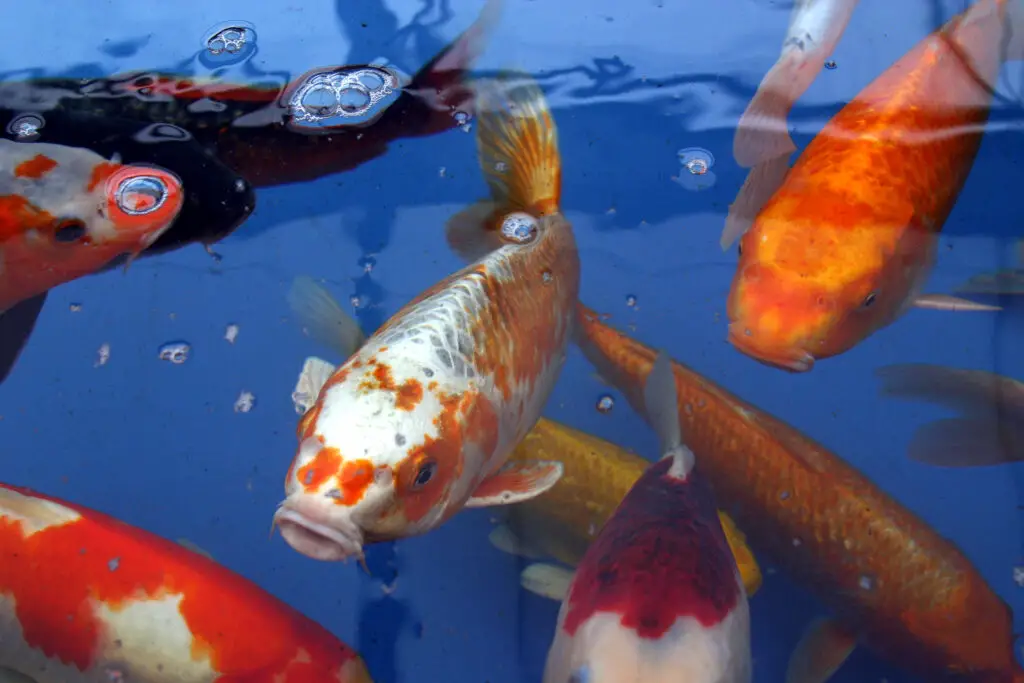
Koi fish are somewhat finicky with specific water quality preferences and needs. They can also grow to quite a large size, and because of this, their waste products are relatively high. In their natural environment, filtration would occur naturally, and the fish’s waste wouldn’t become a problem. Neither would the naturally occurring waste products such as leaves and other decomposing organic matter that might end up in the water.
Implementation of a filtration system is necessary for a small or large pond environment to ensure that the water quality remains up to scratch. Koi fish can eat quite a substantial amount of food, resulting in large amounts of waste products such as defecation and urination, which taints the water quality and necessitates water filtration. The pond size and the size and quantity of koi fish that the space houses will depend on how often your water needs to be filtered.
Removal of algae that can grow in the water is necessary for a clean pond. At the same time, leaves and other organic matter will fall into the pond creating an unsavory environment for your koi fish, and need to be filtered out. In most cases, you should aim for complete water filtration of your pond every 1 – 2 hours.
The size of your filtration system will depend on the size of your pond, with larger ponds requiring more extensive filtration systems.
Conclusion
Your koi pond’s water needs to go through two primary filtration systems. The first is mechanical filtration, which removes as much organic matter from the water as possible. The second is biological filtration which uses beneficial bacteria which break down the ammonia into nitrites and then further break nitrites down into nitrates. After this, you can also use a UV filter which uses ultraviolet light to kill off phototrophic bacteria, algae, viruses, mold, or protozoans with UV radiation.
References
https://homeguides.sfgate.com/koi-pond-sand-filter-information-94360.html
https://www.wikihow.com/Build-a-Pond-Filter-System
https://www.youtube.com/watch?v=M-eGQS_oSW4https://animals.mom.com/why-is-my-pond-alkaline-12312323.html

